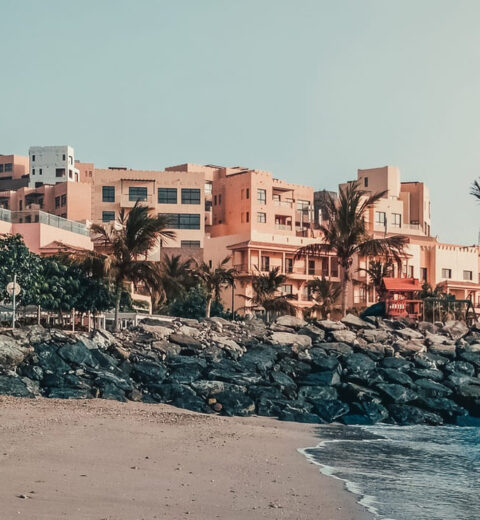The Al Sharqi family is the ruling royal family of Fujairah, one of seven emirates united by the United Arab Emirates (UAE).
Establishing Fujairah
The name is derived from the unity of Sharqiyin, a long-standing nation on the east coast of the Trucial States (and the second most populous in the area around the beginning of the 19th century), a place is known as Shamamailiyah. Sharqiyin has traditionally relied on Sharjah and, over the centuries, made several attempts to engage and proclaim independence, finally controlling this completely from 1901 onwards and finally gaining British recognition as the Trucial Empire in 1952.
List of Al Sharqi Rulers
• 1879–1936: Hamad bin Abdullah Al Sharqi
• 1936–1938: Saif bin Hamad Al Sharqi
• 1938–1975: Mohammed bin Hamad Al Sharqi
• 1975 – present: Hamad bin Mohammed Al Sharqi
Hamad bin Abdullah Al Sharqi
Sheikh Hamad bin Abdullah Al Sharqi is the first known leader of the Al Sharqi Ruling family of Fujairah, one of the Trucial States and now one of the United Arab Emirates (UAE). [1] He led Fujairah in several revolts against Al Qasimi’s law, which governed a tumultuous period in which the emirate was independent but refused to accept the status quo as the Trrucial Empire itself by the British.
Insurrection
Hamad was governor of the city of Fujairah in 1879 when he led a coup in the spring of that year against Sheikh Saqr bin Khalid Al Qasimi of Sharjah, who claimed suzerainty over the Gulf of Oman coast (known as Shamamaliyah) and imposed a slave called Sarur on the Fujairah case. This follows a long period of disputed ownership of coastal areas between Al Qasimi of Sharjah and Ras Al Khaimah and the Sultan of Muscat. A peace settlement was laid before the Governor of Ras Al Khaimah for resolution and, in 1881, Hamad bin Abdullah signed a document confirming his reliance on Sharjah. It was a British view at the time that ‘complete independence of Fujairah should not be encouraged’. However, Hamad was a troubled subject and played both Sharjah and Ras Al Khaimah alone, as well as involving the Sultan in Muscat wherever he was.
Saif bin Hamad Al Sharqi
Sheikh Saif bin Hamad Al Sharqi was the Sheikh of Fujairah from 1936-1938 and the head of the Sharqiyin tribe. In general the reliance on Sharjah, then Abu Dhabi, Fujairah was successfully independent following many disputes, at least with its neighbors, the Sharjah dependence of Kalba and Khor Fakkan. Sheikh Said bin Hamad took over from his long-serving father Hamad Al Sharqi, who had fought for his life fighting for freedom of Fujairah of Sharjah and the recognition of the British Fujairah as the Glorious Kingdom itself. That dream was to be fulfilled in his younger brother, Mohammed bin Hamad, who confessed in 1938 or 1939 at the death of Saif.
Mohammed bin Hamad Al Sharqi
Sheikh Mohammed bin Hamad Al Sharqi (1908 – 6 September 1974) was the Governor of Fujairah, one of the Truck Countries today forming the United Arab Emirates (UAE), from 1938-1974. In 1952 he would see his father’s dream of Fujairah’s long-standing independence from the British, and soon thereafter to help take the UAE into independence as a nation, in 1971.
Accession
Mohammed bin Hamad succeeded as head of the Sharqiyin tribe and Sheikh of Fujairah in 1939 with the death of his older brother, Saif bin Hamad, and he soon began to consolidate places held in Sharqiyin in Fujairah and surrounding areas. In 1950, he had conquered Dibba in the North, as well as the coastal areas of Bidayah and Sakamkam as well as the important Al Bithnah village Al Bithnah Fort which ruled Wadi Ham.
Trucial Status
The British strongly opposed the recognition of Fujairah’s independence 50 years after the proclamation of Muhammad’s father in 1901. However, in the 1950s PCL, Petroleum Concessions Limited, sought permission to test oil in all of Truckial States and the company needed someone who could ‘do business’. The government (now the affairs of the Trucial States were in the hands of the Foreign Office in London following the independence of India in 1947) decided to give Muhammad bin Hamad the title of Supreme Emperor and agreed in 1952 as the Emirate Emperor of the Seventh Infamous (Kalba, formerly Trucial states in 1939, was reinstated to Sharjah in 1951).
Death
Sheikh Mohammed bin Hamad Al Sharqi died in 1974 or 1975. He was succeeded by his son, Sheikh Hamad bin Mohammed Al Sharqi, Governor of Fujairah.
Hamad bin Mohammed Al Sharqi
Sheikh Hamad bin Mohammed Al Sharqi (born 22 February 1949) is the governor of the Emirate of Fujairah in the United Arab Emirates.
Early Life
Hamad Al Sharqi was born in 1949, the son of Sheikh Mohammed bin Hamad Al Sharqi, former governor of the Emirate of Fujairah, one of the leaders who formed the United Arab Emirates. Her mother, Sheikha Fatima bint Rashid Al Nuaimi, was the daughter of the Emirate king of Ajman; she was the sister of the current ruler of Ajman, Sheikh Humaid bin Rashid Al Nuaimi. In 1974, Sheikh Hamad’s father died and Sheikh Hamad succeeded him on the throne of Fujairah. He has managed his own administration with one hand since then and has taken on the responsibility of representing the UAE in international negotiations. Sheikh Hamad is known as a seated speaker, fluent in English and Arabic; his education at the British school has proved to be beneficial in dealing with foreign dignitaries and other world leaders. For these reasons, and because his family has good relations with the ruling families of Abu Dhabi, Dubai, and Ajman, Sheikh Hamad represents the president of the United Arab Emirates extensively at meetings and international conventions.




